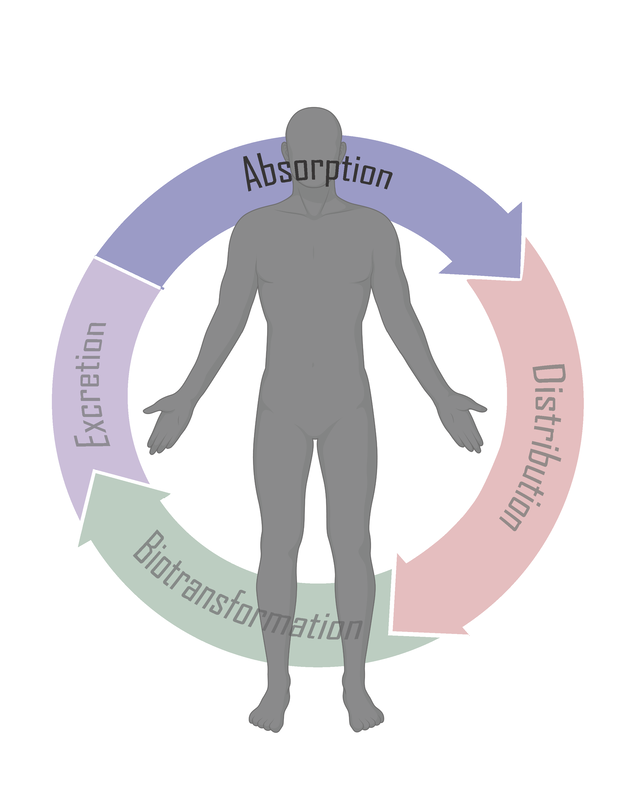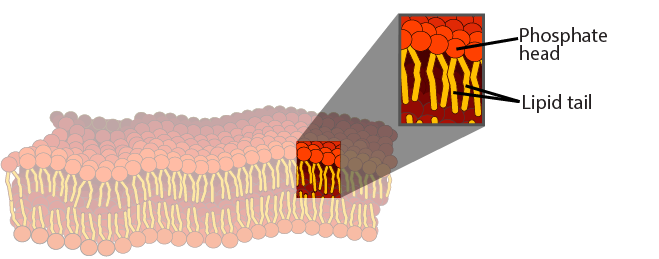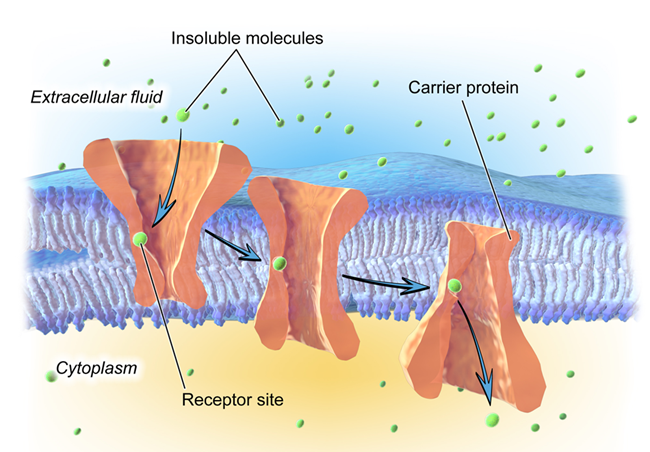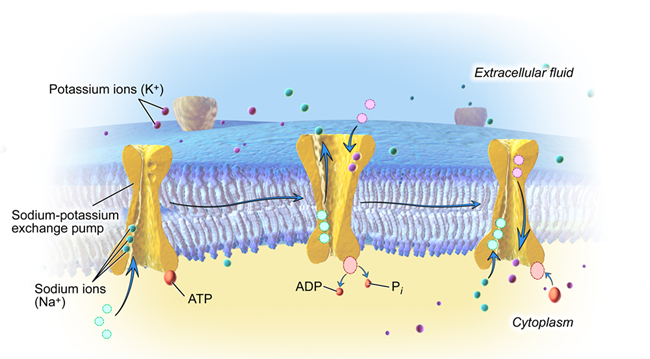Introduction to Absorption
|
Toxicants gain entrance into the body by absorption. The body considers ingested and inhaled materials as being outside of it until those materials cross the cellular barriers of the gastrointestinal tract or respiratory system. A substance must be absorbed to exert an effect on internal organs, although local toxicity, such as irritation, may occur.
|
Figure 1. Processes of toxicokinetics
(Image Source: Adapted from iStock Photos, ©) |
Absorption Variability
Absorption varies greatly by specific chemicals and the route of exposure.
- For skin, oral or respiratory exposure, the absorbed dose is only a fraction of the exposure dose (external dose).
- For substances injected or implanted directly into the body, exposure dose is the same as the absorbed or internal dose.
- Route of exposure.
- Concentration of the substance at the site of contact.
- Chemical and physical properties of the substance.
- For example, very little DDT powder will penetrate the skin whereas a high percentage will be absorbed when it is swallowed.
Routes of Exposure
The primary routes of exposure by which xenobiotics can gain entry into the body are:
- Gastrointestinal (GI) tract — important for environmental exposure to contaminants from food and water; the main route for many pharmaceuticals.
- Respiratory tract — important for environmental and occupational exposure to air contaminants; some pharmaceuticals (such as nasal or oral aerosol inhalers) use this route.
- Skin — important environmental and occupational exposure route; many consumer and pharmaceutical products are applied directly to the skin.
- Injections — primarily used for pharmaceuticals.
- Implants — pharmaceuticals may be implanted to permit slow, time-release (for example, hormones). Many medical devices are implanted for which minimal absorption is desired (such as artificial lens or tendons). Some materials enter the body via skin penetration as the result of accidents or weapons.
- Conjunctival instillations (eye drops) — primarily for treating ocular conditions; however, in some cases, considerable absorption can occur and cause systemic toxicity.
- Suppositories — used for medicines that may not be adequately absorbed after oral administration or that are intended for local therapy; usual locations for suppositories are the rectum and vagina.
Cell Membranes
Cell membranes (often referred to as plasma membranes) surround all body cells and are similar in structure. They consist of two layers of phospholipid molecules arranged like a sandwich, referred to as a "phospholipid bilayer." Each phospholipid molecule consists of a phosphate head and a lipid tail. The phosphate head is polar, meaning it is hydrophilic (attracted to water). In contrast, the lipid tail is lipophilic (attracted to lipid-soluble substances).
The two phospholipid layers are oriented on opposing sides of the membrane so that they are approximate mirror images of each other. The polar heads face outward and the lipid tails face inward in the membrane sandwich (Figure 2).
Figure 2. Each phospholipid molecule consists of a phosphate head and lipid tail
(Image Source: Adapted from Wikimedia Commons, obtained under Public Domain, original image)
(Image Source: Adapted from Wikimedia Commons, obtained under Public Domain, original image)
The cell membrane is tightly packed with these phospholipid molecules interspersed with various proteins and cholesterol molecules. Some proteins span across the entire membrane which can create openings for aqueous channels or pores.
A typical cell membrane structure is illustrated in Figure 3.
A typical cell membrane structure is illustrated in Figure 3.
Figure 3. Typical cell membrane structure (Image Source: Adapted from Wikimedia Commons, obtained under Public Domain, original image)
Role of Cell Membranes in Absorption
For a xenobiotic to enter the body (as well as move within, and leave the body) it must pass across cell membranes (cell walls). Cell membranes are formidable barriers and a major body defense that prevents foreign invaders or substances from gaining entry into body tissues. Normally, cells in solid tissues (such as skin, or mucous membranes of the lung or intestine) are so tightly compacted that substances cannot pass between them. This requires that the xenobiotic have the ability to penetrate cell membranes. It must cross several membranes to go from one area of the body to another.
For a substance to move through one cell requires that it first move across the cell membrane into the cell, pass across the cell, and then cross the cell membrane again to leave the cell. This is true whether the cells are in the skin, the lining of a blood vessel, or an internal organ such as the liver. In many cases, in order for a substance to reach the site where it exerts toxic effects, it must pass through several membrane barriers.
Animation 1 depicts how a chemical from a theoretical consumer product called a "Shower Gel" might get to the surface of the skin during showering and then pass through several membranes before coming in contact with the inside of a liver cell.
Animation 1. From a Gel to a Cell: Following the journey of a chemical from a theoretical shower gel product through several membranes and ultimately into a cell
(Image Source: iStock Photos, ©)
(Image Source: iStock Photos, ©)
Movement of Toxicants Across Cell Membranes
Some toxicants move across a membrane barrier with relative ease while others find it difficult or impossible. Those that can cross the membrane use one of two general methods: 1) passive transfer or 2) facilitated transport.
Passive transfer consists of simple diffusion (or osmotic filtration) and is "passive" because no cellular energy or assistance is required.
Some toxicants cannot simply diffuse across the membrane but require assistance by specialized transport mechanisms. The primary types of specialized transport mechanisms are:
Passive Transfer
Passive transfer is the most common way that xenobiotics cross cell membranes. Two factors determine the rate of passive transfer:
Large water-soluble molecules usually cannot make it through the small pores, although some may diffuse through the lipid portion of the membrane, but at a slow rate.
In general, highly ionized chemicals have low lipid solubility and pass with difficulty through the lipid membrane.
Figure 4 demonstrates the passive diffusion and filtration of xenobiotics through a typical cell membrane.
Some toxicants move across a membrane barrier with relative ease while others find it difficult or impossible. Those that can cross the membrane use one of two general methods: 1) passive transfer or 2) facilitated transport.
Passive transfer consists of simple diffusion (or osmotic filtration) and is "passive" because no cellular energy or assistance is required.
Some toxicants cannot simply diffuse across the membrane but require assistance by specialized transport mechanisms. The primary types of specialized transport mechanisms are:
- Facilitated diffusion
- Active transport
- Endocytosis (phagocytosis and pinocytosis)
Passive Transfer
Passive transfer is the most common way that xenobiotics cross cell membranes. Two factors determine the rate of passive transfer:
- The difference in concentrations of the substance on opposite sides of the membrane (this occurs when a substance moves from a region of high concentration to one having a lower concentration. Diffusion will continue until the concentration is equal on both sides of the membrane).
- The ability of the substance to move either through the small pores in the membrane or the lipophilic interior of the membrane.
- Lipid solubility
- Molecular size
- The degree of ionization
Large water-soluble molecules usually cannot make it through the small pores, although some may diffuse through the lipid portion of the membrane, but at a slow rate.
- Most aqueous pores are about 4 Angstrom (Å) in size and allow chemicals of molecular weight 100-200 to pass through. Exceptions are membranes of capillaries and kidney glomeruli which have relatively large pores (about 40 Angstrom [Å]) that allow molecules up to a molecular weight of about 50,000 (molecules slightly smaller than albumin which has a molecular weight of 60,000) to pass through.
In general, highly ionized chemicals have low lipid solubility and pass with difficulty through the lipid membrane.
Figure 4 demonstrates the passive diffusion and filtration of xenobiotics through a typical cell membrane.
Figure 4. Cellular diffusion
(Image Source: Blausen.com staff (2014). "Medical gallery of Blausen Medical 2014". WikiJournal of Medicine 1 (2). DOI:10. 15347/wjm/2014.010. ISSN 2002-4436. Obtained under Creative Commons license.)
(Image Source: Blausen.com staff (2014). "Medical gallery of Blausen Medical 2014". WikiJournal of Medicine 1 (2). DOI:10. 15347/wjm/2014.010. ISSN 2002-4436. Obtained under Creative Commons license.)
Facilitated Diffusion
Facilitated diffusion is similar to simple diffusion in that it does not require energy and follows a concentration gradient. The difference is that it is a carrier-mediated transport mechanism (Figure 5)—that is, special transport proteins, which are embedded within the cell membrane, facilitate movement of molecules across the membrane. The results are similar to passive transport but faster and capable of moving larger molecules that have difficulty diffusing through the membrane without a carrier.
Facilitated diffusion is similar to simple diffusion in that it does not require energy and follows a concentration gradient. The difference is that it is a carrier-mediated transport mechanism (Figure 5)—that is, special transport proteins, which are embedded within the cell membrane, facilitate movement of molecules across the membrane. The results are similar to passive transport but faster and capable of moving larger molecules that have difficulty diffusing through the membrane without a carrier.
- Examples are the transport of sugar and amino acids into RBCs and the CNS.
Figure 5. Facilitated Diffusion
(Image Source: Blausen.com staff (2014). "Medical gallery of Blausen Medical 2014". WikiJournal of Medicine 1 (2). DOI:10.15347/wjm/2014.010. ISSN 2002-4436. Obtained under Creative Commons license.)
(Image Source: Blausen.com staff (2014). "Medical gallery of Blausen Medical 2014". WikiJournal of Medicine 1 (2). DOI:10.15347/wjm/2014.010. ISSN 2002-4436. Obtained under Creative Commons license.)
Active Transport
Some substances are unable to move with diffusion, unable to dissolve in the lipid layer, and are too large to pass through the aqueous channels. For some of these substances, active transport processes exist in which movement through the membrane may be against the concentration gradient, that is, from low to higher concentrations. Cellular energy from adenosine triphosphate (ATP) is required in order to accomplish this. The transported substance can move from one side of the membrane to the other side by this energy process. Active transport is important in the transport of xenobiotics into the liver, kidney, and central nervous system and for maintenance of electrolyte and nutrient balance.
Figure 6 shows sodium and potassium moving against concentration gradient with the help of the ATP sodium-potassium exchange pump.
Figure 6. Sodium-Potassium Exchange Pump
(Image Source: Blausen.com staff (2014). "Medical gallery of Blausen Medical 2014". WikiJournal of Medicine 1 (2). DOI:10.15347/wjm/2014.010. ISSN 2002-4436. Obtained under Creative Commons license.)
(Image Source: Blausen.com staff (2014). "Medical gallery of Blausen Medical 2014". WikiJournal of Medicine 1 (2). DOI:10.15347/wjm/2014.010. ISSN 2002-4436. Obtained under Creative Commons license.)
Endocytosis (Phagocytosis and Pinocytosis)
Many large molecules and particles cannot enter cells via passive or active mechanisms. However, some may still enter by a process known as endocytosis.
In endocytosis, the cell surrounds the substance with a section of its cell wall. This engulfed substance and section of membrane then separates from the membrane and moves into the interior of the cell. The two main forms of endocytosis are 1) phagocytosis and 2) pinocytosis.
In phagocytosis (cell eating), large particles suspended in the extracellular fluid are engulfed and either transported into cells or are destroyed within the cell. This is a very important process for lung phagocytes and certain liver and spleen cells.
Pinocytosis (cell drinking) is a similar process but involves the engulfing of liquids or very small particles that are in suspension in the extracellular fluid.
Figure 7 demonstrates the types of membrane transport by endocytosis.
Many large molecules and particles cannot enter cells via passive or active mechanisms. However, some may still enter by a process known as endocytosis.
In endocytosis, the cell surrounds the substance with a section of its cell wall. This engulfed substance and section of membrane then separates from the membrane and moves into the interior of the cell. The two main forms of endocytosis are 1) phagocytosis and 2) pinocytosis.
In phagocytosis (cell eating), large particles suspended in the extracellular fluid are engulfed and either transported into cells or are destroyed within the cell. This is a very important process for lung phagocytes and certain liver and spleen cells.
Pinocytosis (cell drinking) is a similar process but involves the engulfing of liquids or very small particles that are in suspension in the extracellular fluid.
Figure 7 demonstrates the types of membrane transport by endocytosis.
Figure 7. Types of Endocytosis
(Image Source: Wikimedia Commons, obtained by Public Domain License, original image)
(Image Source: Wikimedia Commons, obtained by Public Domain License, original image)
Knowledge Check (Solutions on next page)
1) The process whereby a substance moves from outside the body into the body is known as:
a) Distribution
b) Biotransformation
c) Absorption
2) For a xenobiotic to move from outside the body to a site of toxic action requires that it:
a) Possess hydrophilic (water-soluble) properties
b) Possess hydrophobic (lipophilic) properties
c) Pass through several cell membranes
3) The basic structure of the cell membrane consists of:
a) A thick protein layer containing phospholipid channels
b) A bilayer of phospholipids with scattered proteins within the layers
c) Cholesterol outer layer with a phospholipid inner layer
4) The membrane transport process by which large hydrophobic molecules cross membranes via the lipid portion of the membrane, follow the concentration gradient, and do not require energy or carrier molecules is known as:
a) Simple diffusion
b) Active transport
c) Facilitated diffusion
5) Endocytosis is a form of specialized membrane transport in which the cell surrounds the substance with a section of its cell membrane. The specific endocytosis process by which liquids or very small particles are engulfed and transported across the membrane is known as:
a) Phagocytosis
b) Pinocytosis
c) Exocytosis
1) The process whereby a substance moves from outside the body into the body is known as:
a) Distribution
b) Biotransformation
c) Absorption
2) For a xenobiotic to move from outside the body to a site of toxic action requires that it:
a) Possess hydrophilic (water-soluble) properties
b) Possess hydrophobic (lipophilic) properties
c) Pass through several cell membranes
3) The basic structure of the cell membrane consists of:
a) A thick protein layer containing phospholipid channels
b) A bilayer of phospholipids with scattered proteins within the layers
c) Cholesterol outer layer with a phospholipid inner layer
4) The membrane transport process by which large hydrophobic molecules cross membranes via the lipid portion of the membrane, follow the concentration gradient, and do not require energy or carrier molecules is known as:
a) Simple diffusion
b) Active transport
c) Facilitated diffusion
5) Endocytosis is a form of specialized membrane transport in which the cell surrounds the substance with a section of its cell membrane. The specific endocytosis process by which liquids or very small particles are engulfed and transported across the membrane is known as:
a) Phagocytosis
b) Pinocytosis
c) Exocytosis








